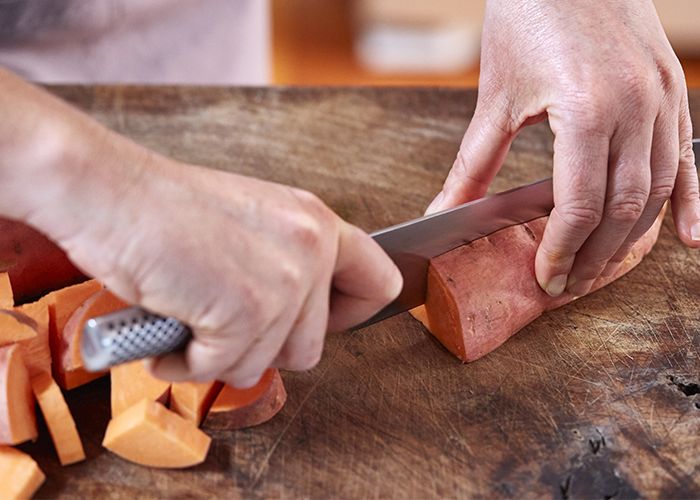A sharp, well-maintained knife is an essential kitchen tool that makes food preparation more enjoyable and efficient. Nonetheless, the most common way of keeping your blades in top condition requires the utilization of blade sharpeners, which, on the off chance that not took care of appropriately, can represent specific dangers.
We will discuss the significance of knife sharpener safety and offer comprehensive safety advice in this article to guarantee a safe and efficient sharpening experience. Let’s read below “What are the safety tips for using knife sharpeners?”
I. Understanding Knife Sharpener Types:
Understanding the various types of knife sharpeners on the market is essential before diving into safety tips. The three fundamental classifications are:
Whetstones: Stones, whether natural or synthetic, are needed to sharpen a knife by hand. They are available in a variety of grits with varying degrees of abrasiveness.
Sharpening Poles or Prepares: Between sharpening sessions, these tools are used to keep the knife’s edge sharp. Honing rods assist in realigning the blade rather than removing material.
Sharpeners—Manual and Electric: These are gadgets intended to rapidly and effectively hone blades. Electric sharpeners utilize controlled crushing wheels, while manual sharpeners might have rough surfaces or openings for manual crushing.
What are the safety tips for using knife sharpeners?
General Safety Tips for Knife Sharpening:
Peruse the Manual: Continuously start by perusing and grasping the maker’s guidelines for your particular blade sharpener. There may be distinctive features and safety precautions for each type and brand.
Wear Defensive Stuff: Always prioritize safety first. While sharpening, you should think about donning gloves that are resistant to cuts to safeguard your hands from erroneous slips or mistakes.
Work Surface Security: Make sure your work surface is secure and stable. During the sharpening process, this prevents accidents caused by wobbling or instability.
Review the Blade: Prior to honing, examine the blade for any harm or issues. A harmed blade can represent extra dangers during honing.
Safety Tips for Whetstone Sharpening:
Let the Whetstone soak: On the off chance that you are utilizing a water stone, make a point to absorb it water for the suggested time before use. This forestalls overheating and guarantees a smoother honing process.
Keep a Reliable Point: Ensure that the sharpening angle stays the same throughout the process. Although this can vary, most knives require an angle of 20 degrees. For the recommended angle, consult your knife’s manual or the manufacturer’s instructions.
Utilize Legitimate Procedure: Whether you’re utilizing a round or volatile movement, keep a consistent and controlled development. Try not to apply extreme strain, as it can prompt lopsided honing and expected injury.
Safety Tips for Honing Rods or Steels:
Pick the Right Bar: Select a sharpening pole that matches the hardness of your blade. Rather than honing the blade, using the wrong rod can cause damage.
Hold the Bar Appropriately: Handle the sharpening bar safely with one hand while holding the blade with the other. Maintain a safe distance from the edge that is being sharpened and keep your fingers away from the blade.
Gain proficiency with the Right Strategy: Utilize smooth and controlled strokes while sharpening the blade. Rather than removing material, the objective is to realign the edge.
Safety Tips for Electric and Manual Sharpeners:
Secure the Blade: Before beginning the process of sharpening the knife, check to see that it is securely seated in the appropriate slot or position. Free blades can prompt capricious developments and mishaps.
Avoid Sharpening Too Much: Over-honing can cause exorbitant intensity development, prompting possible harm to the edge. Follow the manual’s instructions for how long to sharpen.
Routinely Perfect the Sharpener: During the sharpening process, any debris or metal shavings that may accumulate should be removed from the sharpener. A perfect sharpener guarantees ideal execution and security.
Additional Safety Considerations:
Safely store sharpeners: Store your sharpening tools in a safe place when not in use. This forestalls mishaps and guarantees that they stay looking great.
Instruct Others: If you share a kitchen with other people, make sure they understand how to use the knife sharpener safely. Education lowers the likelihood of accidents brought on by careless handling.
Review the Edge Subsequent to Honing: After sharpening your knife, check the blade for any oddities. The edge of a sharp knife ought to be constant and free of nicks or chips.
Conclusion:
Knives must be kept sharp to ensure safety and efficiency in the kitchen. Be that as it may, the most common way of honing ought to be drawn closer with wariness and regard for the apparatuses involved. By following the wellbeing tips illustrated in this article, you can guarantee a protected and viable honing experience, dragging out the existence of your blades and upgrading your culinary undertakings. Keep in mind that when used with care and proper technique, a sharp knife is safe. I hope you like reading “What are the safety tips for using knife sharpeners?”

